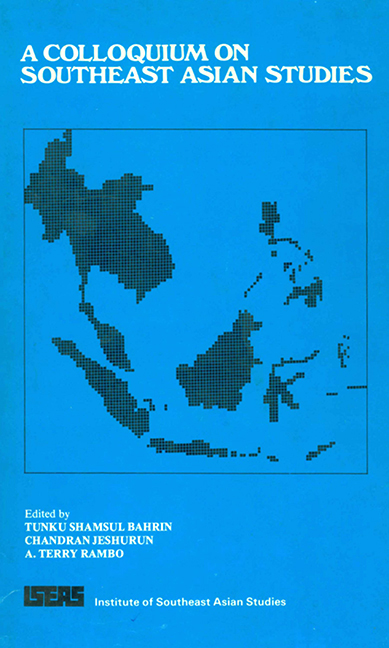Book contents
- Frontmatter
- Contents
- Foreword
- Preface
- Acknowledgements
- Introduction
- Contributors
- PART I TEACHING AND RESEARCH
- PART II ENVIRONMENT AND DEVELOPMENT
- 15 Environment and Development: The Place of Human Ecology in Southeast Asian Studies Programmes
- 16 Environment and Development in Southeast Asia: Trends, Themes and Issues
- 17 Development, Environmental Quality and the Quality of Life in Peninsular Malaysia
- 18 Environment Implications of the Mekong Development Programme
- 19 Development and Environment in Thailand
- 20 Review of Environmental Affairs in Indonesia
- 21 Research and Teaching on Human Ecology in Malaysia
- 22 Human Ecology in the Philippines: Developments in Research, Teaching and Applications
- 23 Environment Education Needs within A Southeast Asian Studies Programme
20 - Review of Environmental Affairs in Indonesia
from PART II - ENVIRONMENT AND DEVELOPMENT
Published online by Cambridge University Press: 21 October 2015
- Frontmatter
- Contents
- Foreword
- Preface
- Acknowledgements
- Introduction
- Contributors
- PART I TEACHING AND RESEARCH
- PART II ENVIRONMENT AND DEVELOPMENT
- 15 Environment and Development: The Place of Human Ecology in Southeast Asian Studies Programmes
- 16 Environment and Development in Southeast Asia: Trends, Themes and Issues
- 17 Development, Environmental Quality and the Quality of Life in Peninsular Malaysia
- 18 Environment Implications of the Mekong Development Programme
- 19 Development and Environment in Thailand
- 20 Review of Environmental Affairs in Indonesia
- 21 Research and Teaching on Human Ecology in Malaysia
- 22 Human Ecology in the Philippines: Developments in Research, Teaching and Applications
- 23 Environment Education Needs within A Southeast Asian Studies Programme
Summary
Brief History
In Indonesia environmental affairs came to the attention of the public only in the early 1960s. Owing to the political conditions at that time, when political issues were major news, the environment was not much publicised. After 1965, when the policy of the government shifted from politics to economic development, more news about the environment appeared in the mass media. This news was primarily, if not entirely, about environmental pollution. This can be easily understood, since the source of the news was the developed countries, particularly the United States. Smog, pesticide residues in food and the environment, and industrial pollution were frequently mentioned in newspapers and popular journals. These problems were discussed as though they were our major concern. But there were also feelings that environmental problems were none of our business and that they were entirely the problems of the developed countries.
In 1968 the new government launched the first five-year development plan, commonly known by its acronym Repelita 1. However, there were fears that concern for environmental pollution could inhibit the implementation of Repelita 1. As the economic condition of Indonesia in the late 1960s was very bad — in 1965 the annual rate of inflation was more than 700% — economic development had very strong popular support, and pollution, although frequently mentioned, remained very much in the back of the minds of most people. With the improvement of the economy of the country, however, environmental pollution gradually came more to the forefront. The first test-case happened in 1973, when the provincial government of West Java temporarily closed a steel pipe plant near Bandung, because the surrounding residents complained that they suffered from the dust emitted from the smoke stacks of the plant. In September 1977 the provincial government of East Java took a more drastic step by closing several industries along the Brantas river which were accused of polluting the river by their effluents and causing the mass death of fish.
- Type
- Chapter
- Information
- A Colloquium on Southeast Asian Studies , pp. 256 - 269Publisher: ISEAS–Yusof Ishak InstitutePrint publication year: 1981



